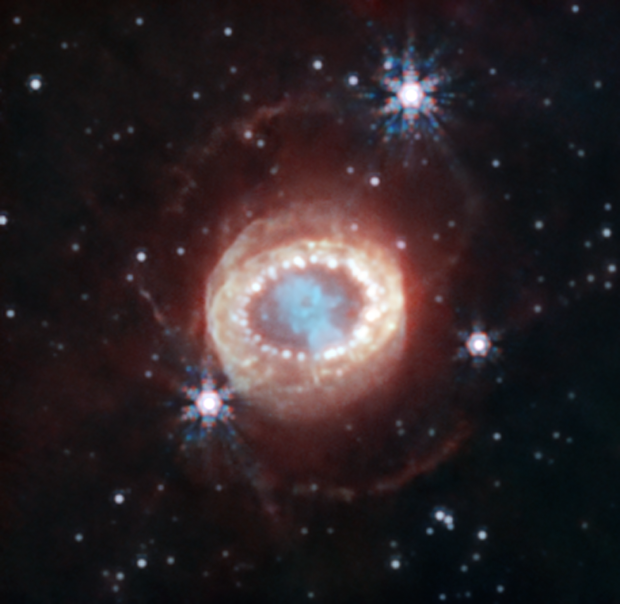
Supernova 1987A, as seen by JWST’s NIRcam instrument. Credit: Science: NASA, ESA, CSA, Mikako Matsuura (Cardiff University), Richard Arendt (NASA-GSFC, UMBC), Claes Fransson (Stockholm University), Josefin Larsson (KTH). Image Processing: Alyssa Pagan (STScI)
The James Webb Space Telescope (JWST) recently imaged Supernova 1987A (also called SN 1987A), revealing a keyhole structure at its center. The supernova resides within the Large Magellanic Cloud (LMC), about 168,000 light-years from Earth, and was first noticed when researchers saw a new source of light in the LMC created by the death of a massive star. (The star initially exploded in 165,000 B.C. but its light did not arrive at Earth until 1987.)
Supernovae and their remnants are also known as “pollinators of the universe” — these chaotic explosions spew elements like iron, calcium, carbon, and more, which are ultimately incorporated into future stars and planets. SN 1987A’s new portrait kicks off JWST’s observations of the renowned supernova. The findings provide clues into how a supernova’s development over time shapes its remnant.
Decades of portraiture
Since its appearance, SN 1987A has been a hotspot for study. In the last 36 years, scientists have continuously imaged and kept tabs on the brightening ring around the supernova. Its flashy light show and its proximity to Earth give astrophysicists a unique opportunity to understand the phases before, during, and after the death of a star. For example, images taken by the Hubble Space Telescope between 1994 and 2016 reveal that the dense ring of gas glows in optical light. This ring was present at least 20,000 years before the star died; when the star exploded, the energetic ultraviolet light it released excited the gas, creating a glowing effect observed for decades.
Observations taken by the now-retired Spitzer Space Telescope and the Chandra X-Ray Observatory have also revealed other features over the years. Between 1999 to 2013, data collected from Chandra found a brightening, expanding region of X-ray emission. In recent years, the ring has stopped brightening, suggesting that the explosion’s blast energy has moved from the initial ring into an area with less gas.
Credit: NASA, ESA, and R. Kirshner (Harvard-Smithsonian Center for Astrophysics and Gordon and Betty Moore Foundation), and P. Challis (Harvard-Smithsonian Center for Astrophysics)New details emerge
The new JWST image, taken with the Near-infrared camera (NIRCam), reveals the remnant’s central structure. Its center is filled with clumpy gas and dust thrown out by the supernova explosion. In fact, the dust in that area is so dense that infrared light can’t penetrate it, which is why there appears to be a dark “hole” in the middle. JWST also found small, crescentlike structures in the central region. These are thought to be from outer layers of gas pushed out from the explosion, though their bright appearance may also be due to the angle at which we are viewing them.
JWST’s new photo also shows SN 1987A’s equatorial ring, which connects the two faint arms that create its Venn diagram or hourglass shape. The brighter spots within and beyond the ring are caused by shock waves smacking into the material as they expand.
Observers have been trying to uncover SN 1987A’s secrets for decades, but more remain — such as evidence of a black hole or a neutron star that should have formed in the blast’s aftermath. As JWST continues its mission, it will also continue to watch and note changes to the supernova remnant over time.





